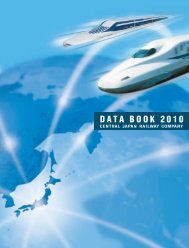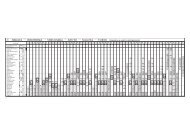CENTRAL JAPAN RAILWAY COMPANY Annual Report 2007
CENTRAL JAPAN RAILWAY COMPANY Annual Report 2007
CENTRAL JAPAN RAILWAY COMPANY Annual Report 2007
Create successful ePaper yourself
Turn your PDF publications into a flip-book with our unique Google optimized e-Paper software.
o. Consumption Tax<br />
Consumption tax is levied in Japan on the domestic sales of goods and services at the rate of 5%. Consumption tax is excluded from revenues and expenses.<br />
p. Per Share Information<br />
Basic net income per share is computed by dividing net income available to common shareholders by the weighted-average number of common shares<br />
outstanding for the period, retroactively adjusted for stock splits.<br />
The net income available to common shareholders used in the computation for <strong>2007</strong>, 2006 and 2005 were ¥130,141 million ($1,102,889 thousand), ¥115,749<br />
million and ¥90,337 million, respectively. The average number of common shares used in the computation was 1,978,000 shares for <strong>2007</strong>, 2,240,000 shares<br />
for 2006 and 2005. Diluted net income per share is not presented in the accompanying non-consolidated financial statements as the Company does not have<br />
any dilutive securities.<br />
Cash dividends per share presented in the accompanying non-consolidated statements of income are dividends applicable to the respective years including<br />
dividends to be paid after the end of the year.<br />
q. Related Party Transaction<br />
Related party transactions other than with subsidiaries are not presented herein, as they are disclosed in the consolidated financial statements of the Company<br />
and consolidated subsidiaries.<br />
r. New Accounting Pronouncements<br />
Measurement of Inventories<br />
Under generally accepted accounting principles in Japan, inventories are currently measured either by the cost method, or at the lower of cost or market. On July 5, 2006, the<br />
ASBJ issued ASBJ Statement No.9, “Accounting Standard for Measurement of Inventories”, which is effective for fiscal years beginning on or after April 1, 2008 with early<br />
adoption permitted. This standard requires that inventories held for sale in the ordinary course of business be measured at the lower of cost or net selling value, which is<br />
defined as the selling price less additional estimated manufacturing costs and estimated direct selling expenses. The replacement cost may be used in place of the net selling<br />
value, if appropriate. The standard also requires that inventories held for trading purposes be measured at the market price.<br />
Lease Accounting<br />
On March 30, <strong>2007</strong>, the ASBJ issued ASBJ Statement No.13, “Accounting Standard for Lease Transactions”, which revised the existing accounting standard for lease<br />
transactions issued on June 17, 1993.<br />
Under the existing accounting standard, finance leases that deem to transfer ownership of the leased property to the lessee are to be capitalized, however, other finance leases<br />
are permitted to be accounted for as operating lease transactions if certain “as if capitalized” information is disclosed in the note to the lessee’s financial statements.<br />
The revised accounting standard requires that all finance lease transactions should be capitalized. The revised accounting standard for lease transactions is effective for fiscal<br />
years beginning on or after April 1, 2008 with early adoption permitted for fiscal years beginning on or after April 1, <strong>2007</strong>.<br />
4. ACCOUNTING CHANGES<br />
Effective April 1, 2004, the Company adopted the declining-balance method of depreciation for the buildings and structures of the Shinkansen railway ground<br />
facilities, which had been previously depreciated by the straight-line method which had been different from method adopted for conventional railway network<br />
since assuming the Shinkansen railway ground facilities. This change was made to reinforce the financial position and unify the method of Shinkansen<br />
railway ground facilities to that of conventional railway network in connection with both commencement of Shinagawa station and drastic timetable revisions<br />
focusing on completion of improving the Shinkansen trains to operate at 270 km/hr.<br />
The effects of this change were to increase depreciation by ¥39,817 million and to decrease operating income and income before income taxes, respectively,<br />
by approximately ¥39,817 million for the year ended March 31, 2005.<br />
5. PROPERTY AND EQUIPMENT<br />
Property and equipment as of March 31, <strong>2007</strong> and 2006, consisted of the following:<br />
<br />
<br />
<br />
<br />
<br />
<br />
Total<br />
<br />
Net property and equipment<br />
<br />
<br />
<br />
<strong>2007</strong> 2006 <strong>2007</strong><br />
¥ 2,330,051<br />
484,508<br />
3,381,554<br />
745,585<br />
408,277<br />
109,270<br />
7,459,248<br />
(2,995,489)<br />
¥ 4,463,759<br />
¥ 2,332,925<br />
470,191<br />
3,393,731<br />
727,937<br />
383,751<br />
92,484<br />
7,401,022<br />
(2,859,058)<br />
¥ 4,541,963<br />
$ 19,746,194<br />
4,106,000<br />
28,657,237<br />
6,318,516<br />
3,459,974<br />
926,045<br />
63,213,966<br />
(25,385,500)<br />
$ 37,828,466<br />
6. LONG-LIVED ASSETS<br />
The Company recognizes all properties of the railway business as one asset group, which includes both the Shinkansen railway ground facilities and<br />
conventional railway network. The business properties other than railway business properties are also principally divided into each asset groups in which the<br />
Company continuously receives cash flows in consideration of complementary cash flows.<br />
The Company reviewed its long-lived assets for impairment as of the year ended March 31, 2005 and, as a result, recognized an impairment loss of ¥1,005<br />
million as other expense for land in Aichi or other areas, which are included in construction in progress, due to having been idle by freezing plans of increasing<br />
lines. These carrying amounts were written down to the recoverable amounts, which were measured at memorandum value, due to the fact that there were little<br />
opportunities to sell or divert those assets.<br />
56





